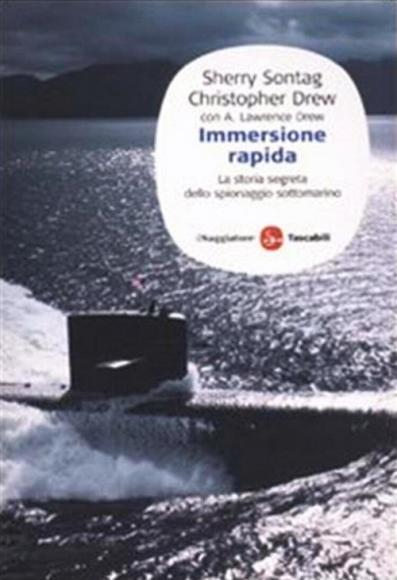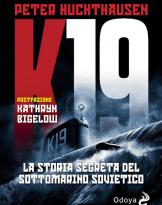Sherry Sontag - Christopher Drew
Ed. The Assayer
pp. 444
"This book is about submarines, espionage and geopolitics, but it's also a book about people ". It is a story that took place during the cold war that was told by the authors, both journalists; it is a story of submarines chasing other submarines; it is a story that involved thousands of men who, locked in cramped steel cylinders, spied on other men: on one side the United States, on the other the Soviet Union.
These"Submarine spies guarded, like silent sentinels, the fronts of a war fought harshly on both sides. Only in that war the most important weapons were not the torpedoes, but the cameras, the sonar and a whole series of complicated listening equipment. "
About two thousand espionage missions were carried out by American submarines for the control of Soviet submarines: more than one football field, the latter could carry up to twenty ballistic missiles and each missile could launch up to ten nuclear warheads.
"There was only one way to counter the missiles carried on submarines: with other submarines." Submarines, those Americans, that for the Soviets "They were more than an enemy: they were a constant curse."
The first protagonist of this story is the submarine Cochino, under the command of Rafael Benitez. It was the last submarine that entered service during the Second World War, two weeks after the first atomic bomb was unlatched and that, at the end of the war, along with a few other boats, had been radically changed with the installation of the snorkel, a passive sonar and other improvements that would have made him the acronym of GUPPY, who was going to Greater Underwater Propulsion Power, that is, greater underwater propulsion power.
The 20 August 1949 the Cochino and Tusk, which had undergone the same changes, were in the Barents sea. On board the Cochino there was also Harris M.Austin, a "spy" who worked for the Naval Security Group, "The legendary cryptographic service that had intercepted and deciphered the most important communications of the Japanese Navy during the Second World War." The August 25, the batteries of one of the two compartments where they were installed, went up in flames. The Tusk, which had separated from Cochino to carry out the sonar test, he came to the rescue. Despite the enormous efforts of Commander Benitez and his crew, who in the meantime had moved on Tusk, Cochino the August 26 sank. Not everyone managed to save themselves and some of the men died too Tusk. Later it was realized that the snorkel, despite having revolutionized the submarine war, had heavy limitations. Thus the road to nuclear propulsion was opened.
Admiral Hyman G. Rickover was the father of the nuclear submarine. John P.Craven instead was commissioned by Admiral Red Raborn to study the inviolate realm of great depths, to work with his group on new ideas: "Missiles to be placed at the bottom of the ocean, miles from the surface; submarines able to get there and see through the darkness of the abyss, transporting cameras in foreign waters never traveled. " But the admirals were not interested in deep water dives, as they considered them more difficult than the launch of men in space, until, the 10 April 1963, the accident occurred, during a test dive, to the Tresher - first example of a new class of attack nuclear submarines designed to plunge more than the other submarines of the era - which caused the sinking of the submarine and the death of the 129 crewmen, did not bring the navy to finance, with substantial sums, the Safe Submarine Program, which relates to rescue vehicles for the great depths, a program that also aroused the interest of the Office of Naval Intelligence. That's how the submarine Halibut, after a suitable adaptation, he became the laboratory of Craven and was employed in espionage missions.
Another tragedy, meanwhile, the 27 May of the 1968, would hit the submarine Scorpion who disappeared with his 99 crewmen. The most reliable hypothesis was that the incident was caused by the spontaneous ignition of the explosive warhead of a torpedo, triggered by the battery fire, perhaps defective. In the 1970 theHalibut he was sent to the sea of Ohotsk in search of a submarine telephone cable that allowed the Soviets to communicate. Once found, some divers had to get out of the submarine to connect the recording device to the cable itself, so that they could gather a rich sample of rumors and transmissions of Soviet data. THE'Halibut he also discovered the place where Soviet missiles were going to die, missiles that had new infrared guidance that the US Navy had not been able to neutralize. So the divers collected some fragments of missiles to be analyzed.
In the 1978 it was the turn of the submarine Patch, tasked with intercepting Soviet communications in the Barents Sea - where the Soviet submarine bastion stood - a mission that had fascinated President Carter, who had been a nuclear engineer who was a follower of Rickover, before having to occupy himself after his father's death , of the family peanut crops. The hunt for Soviet information continued inexorably until 1991, when the US enemy became Iraq, so that there was a drastic cut in the number of missions off the Soviet coast.
However, with the dissolution of the Soviet Union, Russia remained the second underwater power in the world and "as long as the bear will continue to swim " it will be necessary to monitor it. The fact remains that "Perhaps the whole nuclear arms race had been crazy, but, since there was, the spy submarines became a crucial element of that madness."
Gianlorenzo Capano












